As Comet 2011 L4 PanSTARRS moves out of the inner solar system, we’ve got another comet coming into view this month for northern hemisphere observers.
Comet C/2012 F6 Lemmon is set to become a binocular object low to the southeast at dawn for low northern latitudes in the first week of April. And no, this isn’t an April Fools’ Day hoax, despite the comet’s name. Comet Lemmon (with two m’s) was discovered by the Mount Lemmon Sky Survey (MLSS) based outside of Tucson, Arizona on March 23, 2012. MLSS is part of the Catalina Sky Survey which searches for Near Earth Asteroids. We’ve got another comet coming into view this month for northern hemisphere observers as Comet 2011 L4 PanSTARRS moves out of the inner solar system.
The comet is on an extremely long elliptical orbit, with a period of over 11,000 years. Comet Lemmon just passed perihelion at 0.74 astronomical units from the Sun on March 24th.
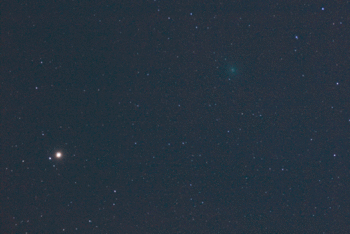
Southern hemisphere observers have been getting some great views of Comet Lemmon since the beginning of this year. It passed only three degrees from the south celestial pole on February 5th, and since that time has been racing up the “0 Hour” line in right ascension. If that location sounds familiar, that’s because another notable comet, 2011 L4 PanSTARRS has been doing the same. In fact, astrophotographers in the southern hemisphere were able to catch both comets in the same field of view last month.
Another celestial body occupies 0 Hour neighborhood this time of year. The Sun just passed the vernal equinox marking the start of Spring in the northern hemisphere and Fall in the southern on March 19th.
And like PanSTARRS, Comet Lemmon has a very steep orbit inclined 82.6° relative to the ecliptic.
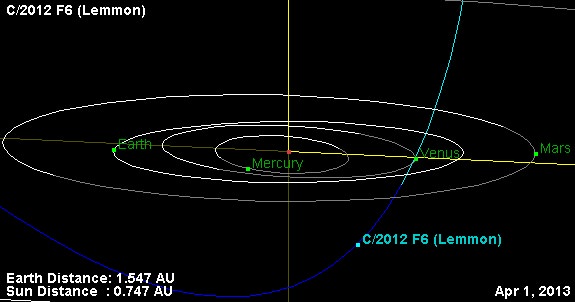
Comet Lemmon broke naked-eye visibility reaching +6th magnitude in late February and has thus far closely matched expectations. Current reports place it at magnitude +4 to +5 as it crosses northward through the constellation Cetus. Predictions place the maximum post-perihelion brightness between magnitudes +3 and +5 in early April, and thus far, Comet Lemmon seems to be performing right down the middle of this range.
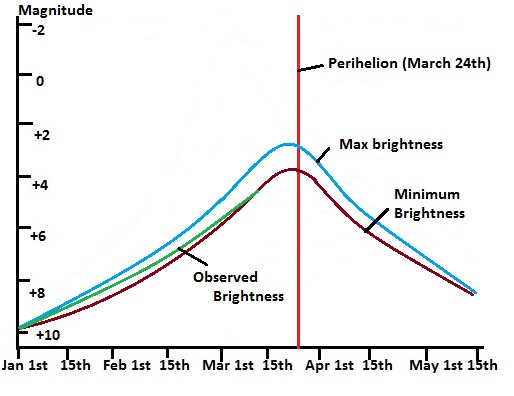
Southern observers have caught a diffuse greenish 30” in diameter nucleus on time exposures accompanied by a short, spikey tail. Keep in mind, the quoted brightness of a comet is extended over its entire surface area. Thus, while a +4th magnitude star may be easily visible in the dawn, a 3rd or even 2nd magnitude comet may be invisible to the unaided eye. Anyone who attempted to spot Comet PanSTARRS in the dusk last month knows how notoriously fickle it actually was. Binoculars are your friend in this endeavor. Begin slowly sweeping the southeast horizon about an hour before local sunrise looking for a fuzzy “star” that refuses to reach focus. Comet Lemmon will get progressively easier in the dawn sky for latitudes successively farther north as the month of April progresses.
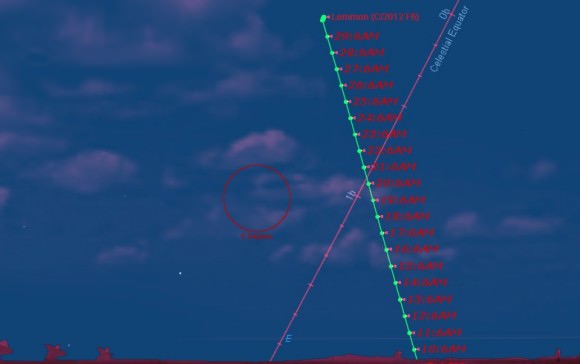
Comet Lemmon will continue to gain elevation as it crosses from Cetus into the constellation Pisces on April 13th. An interesting grouping occurs as the planet Mercury passes only a few degrees from the comet from April 15th to April 17th. Having just past greatest elongation on March 31st, Mercury will shine at magnitude -0.1 and make a good guide to locate the comet in brightening dawn skies. The pair is joined by the waning crescent Moon on the mornings of April 7th and 8th which may also provide for the first sighting opportunities from low north latitudes around these dates.
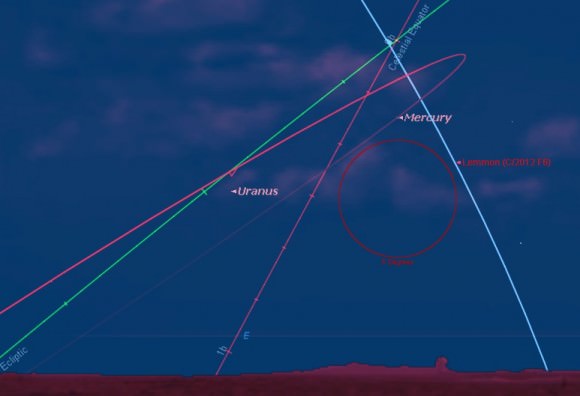
The Moon reaches New phase on Wednesday, April 10th at 5:35AM EDT/9:35 UT. It will be out of the morning sky for the next couple of weeks until it reaches Full on April 25th, at which point it will undergo the first eclipse of 2013, a very shallow partial. (More on that later this month!)
Comet Lemmon will then slide across the celestial equator on April 20th and cross the plane of the ecliptic on April 22nd as it heads up into the constellation Andromeda in mid-May. We’re expecting Comet Lemmon to be a fine binocular object for late April, but perhaps not as widely observed due to its morning position as PanSTARRS was in the dusk.
By mid-May, Comet Lemmon will have dipped back down below +6th magnitude and faded out of interest to all but a few deep sky enthusiasts. Comet Lemmon will pass within 10° of the north celestial pole on August 9th, headed back out into the icy depths of the solar system not to return for another 11,000-odd years.
It’s interesting to see how these two springtime comets will effect observers expectations for the passage of Comet C/2012 S1 ISON. Will this in fact be the touted “Comet of the Century?” Much hinges on whether ISON survives its November 28th perihelion only 1,166,000 kilometers from the center of our Sun (that’s 0.68 solar-radii or about 3 times the Earth-Moon distance from the surface of the Sun). If so, we could be in for a fine “Christmas Comet” rivaling the passage of Comet Lovejoy in late 2011. On the other hand, a disintegration of Comet ISON would be more akin to the fizzle of Comet Elenin earlier in 2011.
In the meantime, enjoy Comet Lemmon as an Act 2 in the 2013 Three Act “Year of the Comet!”

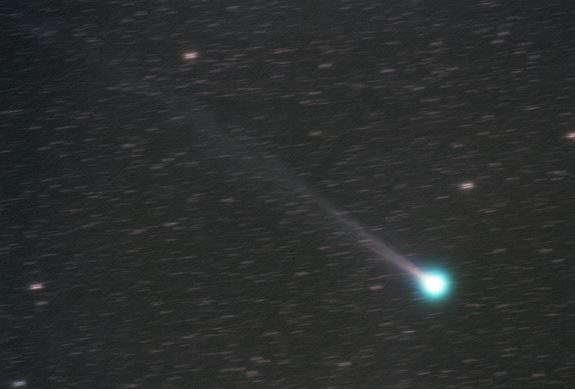
Well alrighty then! I will definitely make however many attempts it takes to see this comet! It will be #47 for me if I am successful. Comet PanStarrs was a difficult viewing for me – it took several trips out to the OH SO COLD coast to finally see it! Hope this puppy behaves a lil bit better and the WX co-operates! Yasss……*
P.S. Thanks for the finder chart!
Thanks; the problem with dropping in constellations in a dawn finder chart along with the local horizon is they shift over the span of the month. Building chart showing a comet’s path over the span of weeks usually leaves you with showing one or the other for the sake of clarity. Thanks for posting.
I guess I’ve grown used to seeing comet tracks on sky charts with constellations included for ref., but see your point and haven’t used Starry Night software.
No problem, thanks for the feedback. Nothing says we can’t include both in the future… Cometography includes links to constellation based charts, though I noticed they’re not updated for April yet: http://cometchasing.skyhound.com/
I just got back from Chile. Here is a pic of Comet Lemmon taken from CTIO. http://halfastro.wordpress.com/2013/03/16/comet-lemmon/
Great shot Rob! Thanks for the update.. You mentioned that the comet was
‘blue’, where the reports I’ve seen said it is more ‘greenish’…. maybe
‘aguamarine’ is more like it?
It looked more blue to me visually, although I have seen more people refer to it as greenish and seen some pics that would back up the green. Some people do see slightly different colors visually so I would chalk it up to differences in visual color perception. I am back in the U.S. now and am looking forward to getting another shot at it and will let you know if I change my mind on he color 🙂
Please, oh please, insert larger pictures in your articles. The picture showing the path of the comet is too small to be able to read the dates, which makes it useless. Also, since Universe Today has so many beautiful pictures, it would be nice to be able to set them as computer backgrounds. That would take a significant increase in size tho. But at least make them legible. Thanx.
Space was always my interest from a child. Teachers/Prof’s from grade, high, collage/university schools drilled it into me about Halley’s Comet. That is/was why Halley’s comet was so important to me. They got me so interested in Halley’s Comet that I ended up studying asteroids etc’s.. & ended up in R&D in the field of Probes/Sat-Com’s protection. The fact it came by every 76 yrs or so, I’d better get a look at it I’d never see it because if I didn’t, I’d be 100+ yrs old the next time around….lol. After that no other comet gave me the interest the way Halley’s comet did. Take care all.
tinyurl.com/cnaff79
Latitude will matter….I’m at 36 degrees north and I wouldn’t expect to see Mercury at all in April…it is just too low to the horizon. I need at least 5 degrees and a pristine sky (possible, just not probable). Unless I’ve got the orbital elements wrong, I don’t expect Lemmon to come high enough until May since it will not be very bright. It really helps to have 30-35-40 degree maps.
if you are interested in a lot more information on this comet and the disinformation on comets in general listen to this expert: http://podcast.gcnlive.com/podcast/power_hr/0412132.mp3
I have seen comet Lemmon with my naked eye 4/11 & 4/12. I am in Glendale, AZ, 33.58 degrees N by 112.1 degrees W. It is low in the eastern sky just prior to sunrise, before the sun breaks the horizon at about 5:50 AM. It is even better than PanStarrs which I saw on 6 or 7 days at sunset looking west. I t has a very looong tail.